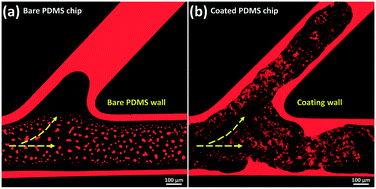Our official English website, www.x-mol.net, welcomes your
feedback! (Note: you will need to create a separate account there.)
Geo-material surface modification of microchips using layer-by-layer (LbL) assembly for subsurface energy and environmental applications
Lab on a Chip ( IF 6.1 ) Pub Date : 2017-11-17 00:00:00 , DOI: 10.1039/c7lc00675f Y. Q. Zhang 1, 2, 3, 4, 5 , A. Sanati-Nezhad 3, 4, 5, 6, 7 , S. H. Hejazi 1, 2, 3, 4, 5
Lab on a Chip ( IF 6.1 ) Pub Date : 2017-11-17 00:00:00 , DOI: 10.1039/c7lc00675f Y. Q. Zhang 1, 2, 3, 4, 5 , A. Sanati-Nezhad 3, 4, 5, 6, 7 , S. H. Hejazi 1, 2, 3, 4, 5
Affiliation

|
A key constraint in the application of microfluidic technology to subsurface flow and transport processes is the surface discrepancy between microchips and the actual rocks/soils. This research employs a novel layer-by-layer (LbL) assembly technology to produce rock-forming mineral coatings on microchip surfaces. The outcome of the work is a series of ‘surface-mimetic micro-reservoirs (SMMR)’ that represent multi-scales and multi-types of natural rocks/soils. For demonstration, the clay pores of sandstones and mudrocks are reconstructed by representatively coating montmorillonite and kaolinite in polydimethylsiloxane (PDMS) microchips in a wide range of channel sizes (width of 10–250 μm, depth of 40–100 μm) and on glass substrates. The morphological and structural properties of mineral coatings are characterized using a scanning electron microscope (SEM), optical microscope and profilometer. The coating stability is tested by dynamic flooding experiments. The surface wettability is characterized by measuring mineral oil–water contact angles. The results demonstrate the formation of nano- to micro-scale, fully-covered and stable mineral surfaces with varying wetting properties. There is an opportunity to use this work in the development of microfluidic technology-based applications for subsurface energy and environmental research.
中文翻译:

使用逐层(LbL)组件对微芯片进行土工材料表面改性,用于地下能源和环境应用
在将微流体技术应用于地下流动和输送过程中的一个关键约束是微芯片与实际岩石/土壤之间的表面差异。这项研究采用了一种新颖的逐层(LbL)组装技术,可以在微芯片表面上形成可形成岩石的矿物涂层。这项工作的成果是一系列“地表模拟微储层(SMMR)”,它们代表了多种规模和多种类型的天然岩石/土壤。为了演示,通过代表性地将蒙脱石和高岭石涂覆在聚二甲基硅氧烷(PDMS)微芯片中,在各种通道尺寸(宽度为10–250μm,深度为40–100μm)中以及在玻璃基板上,来重建砂岩和泥岩的粘土孔隙。 。矿物涂层的形态和结构特性使用扫描电子显微镜(SEM),光学显微镜和轮廓仪进行表征。涂层稳定性通过动态溢流实验进行测试。表面润湿性是通过测量矿物油与水的接触角来表征的。结果表明,形成了具有不同润湿特性的纳米至微米级,完全覆盖且稳定的矿物表面。有机会在开发用于地下能源和环境研究的基于微流体技术的应用程序中使用这项工作。结果表明,形成了具有不同润湿特性的纳米至微米级,完全覆盖且稳定的矿物表面。有机会在开发用于地下能源和环境研究的基于微流体技术的应用程序中使用这项工作。结果表明,形成具有不同润湿特性的纳米至微米级,完全覆盖且稳定的矿物表面。有机会在开发用于地下能源和环境研究的基于微流体技术的应用程序中使用这项工作。
更新日期:2017-11-17
中文翻译:

使用逐层(LbL)组件对微芯片进行土工材料表面改性,用于地下能源和环境应用
在将微流体技术应用于地下流动和输送过程中的一个关键约束是微芯片与实际岩石/土壤之间的表面差异。这项研究采用了一种新颖的逐层(LbL)组装技术,可以在微芯片表面上形成可形成岩石的矿物涂层。这项工作的成果是一系列“地表模拟微储层(SMMR)”,它们代表了多种规模和多种类型的天然岩石/土壤。为了演示,通过代表性地将蒙脱石和高岭石涂覆在聚二甲基硅氧烷(PDMS)微芯片中,在各种通道尺寸(宽度为10–250μm,深度为40–100μm)中以及在玻璃基板上,来重建砂岩和泥岩的粘土孔隙。 。矿物涂层的形态和结构特性使用扫描电子显微镜(SEM),光学显微镜和轮廓仪进行表征。涂层稳定性通过动态溢流实验进行测试。表面润湿性是通过测量矿物油与水的接触角来表征的。结果表明,形成了具有不同润湿特性的纳米至微米级,完全覆盖且稳定的矿物表面。有机会在开发用于地下能源和环境研究的基于微流体技术的应用程序中使用这项工作。结果表明,形成了具有不同润湿特性的纳米至微米级,完全覆盖且稳定的矿物表面。有机会在开发用于地下能源和环境研究的基于微流体技术的应用程序中使用这项工作。结果表明,形成具有不同润湿特性的纳米至微米级,完全覆盖且稳定的矿物表面。有机会在开发用于地下能源和环境研究的基于微流体技术的应用程序中使用这项工作。











































 京公网安备 11010802027423号
京公网安备 11010802027423号